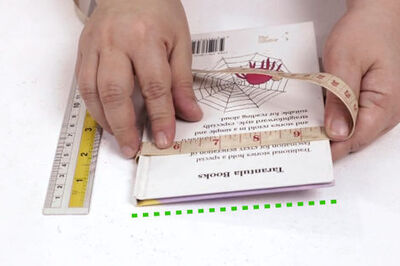
views
Signs That a Sweet Potato Has Gone Bad
Soft spots Pick up the sweet potato and feel it for soft spots. If it feels squishy or mushy in certain areas, your sweet potato is likely past its prime. Fresh sweet potatoes won’t have any soft spots or indentations, and they’ll be very firm to the touch.
Wrinkly skin If your sweet potato’s skin looks shriveled or wrinkly, this is a surefire sign of decay. A wrinkly sweet potato will taste sour or “off,” and it can even cause sickness if eaten, so it’s safest to throw them away.
Discoloration Fresh sweet potatoes should have a uniform color without any dark spots or discoloration. If you see brown or black spots on the sweet potato’s skin or inside the sweet potato, this is a sign of spoilage and possible mold growth. Unfortunately, the sweet potato is no longer safe to eat and should be thrown out.
Oozing liquid As sweet potatoes spoil, they will start to become softer and mushier, and their water content will rise. When this happens, you may notice some mysterious liquid leaking from the potato before you cut it. This is a sign that your sweet potato has gone bad and should be thrown away. Once you cut into your sweet potato, it’s normal to see a bit of white, milky-looking liquid. This liquid is called “sap,” and it’s a combination of the sugar, starch, and moisture inside the potato. The sap is released when your knife slices through the potato, and it’s not a sign of spoilage. Your sweet potato should still be completely safe to eat!
Lots of sprouts If your sweet potato only has a few small sprouts but seems completely fresh otherwise, it’s safe to cut off the sprouted areas and consume the potato. If, however, your sweet potato has grown an excessive amount of large sprouts and it’s also soft or wrinkly, it’s time to toss it out. These sprouts contain compounds called glycoalkaloids, which have a bitter taste and can be toxic when eaten in large quantities.
“Off” smell If your sweet potato starts to have a musty, foul, sour, or intensely sweet odor, it has likely gone bad. These smells indicate bacteria growth, which means your sweet potato isn’t safe to eat anymore. A fresh raw sweet potato should smell earthy, but it shouldn’t smell overly sweet until it’s cooked. As a sweet potato goes bad, bacteria will grow and convert to sugar, which causes this super sweet smell.
Unpleasant taste If a sweet potato has gone bad, it will likely have an unpleasant bitter taste. This comes from the sprouts that grow on the potato, which contain bitter-tasting compounds called glycoalkaloids. It’s dangerous to consume these compounds, so if you notice this taste, stop eating your potato and throw it away. An overly sweet taste can also be a sign of spoilage, but this is harder to spot in sweet potatoes since they are naturally sweet-tasting. However, if you have a regular russet or Yukon gold potato, a super sweet taste is a sign that the starches are breaking down into sugars, which means your potato is past its prime.
How to Pick Sweet Potatoes at the Store
At the grocery store, choose sweet potatoes that feel firm to the touch. Look for smooth, wrinkle-free skin, and make sure there aren’t any soft or mushy areas. Try to pick potatoes that are uniform in color and shape, without any dark spots, blemishes, or indentations. The fresher your potatoes are when you buy them, the longer they’ll last when you store them at home!
How long do sweet potatoes stay fresh?
At room temperature, whole sweet potatoes will last for 2-3 weeks. If you store them in a cooler, darker place, like a pantry or root cellar, the sweet potatoes may even stay fresh a bit longer (up to 5 weeks). Canned sweet potatoes will last for about 1 year. Cooked sweet potatoes can last 3-7 days in the fridge or 4-6 months in the freezer.
How to Store a Sweet Potato to Prolong Freshness
Store whole sweet potatoes at room temperature. For optimal freshness and a long shelf-life, store your sweet potatoes in a cool, dark, dry place. You can place them on the kitchen counter (as long as they’re not under direct sunlight from a window), or you can store them in your pantry. If your pantry is very cool (55 to 60°F), your potatoes may even stay fresh for up to 2 months! Don’t place your sweet potatoes in a Ziploc or plastic bag—this traps moisture and leads to spoilage. Don’t wash your sweet potatoes until you’re ready to cook them. Washing sweet potatoes before storing them can lead to premature mold growth. You might be tempted to put your sweet potatoes in the fridge to prolong their shelf life, but avoid this impulse. Raw sweet potatoes develop an unpleasant taste and hard texture when stored in the fridge.
Store cooked sweet potatoes in the fridge. Once you’ve cooked your sweet potatoes, they need to be refrigerated to stay fresh. Place them in a tightly closed container or tupperware, and store them in the fridge for 3-7 days.
Freeze cooked sweet potatoes for the longest shelf life. You can store sweet potatoes in the freezer to keep them fresh longer, but it’s best to cook them first. (Freezing raw sweet potatoes has a negative effect on the taste and texture.) Before freezing, you can roast them, mash them, blanch them, fry them—whatever you prefer!
Recipe Ideas & Uses for Sweet Potatoes
Sweet potatoes make delicious (and nutritious) additions to your diet. Their unique taste works super well in sweet and savory dishes, and they’re an excellent source of potassium, fiber, and vitamins A, B6, and C. Here are some recipes featuring sweet potatoes if you’re looking for inspiration: Sweet potato fries Baked sweet potatoes Mashed sweet potatoes Grilled sweet potatoes Air fried sweet potatoes


















Comments
0 comment